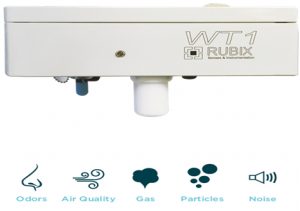Watchtower 1 provides on line autonomous outside air emission monitoring station based on various gas sensors in arrays that provides low ppb gas, (H2S, RSH, NO2, NH3, SO2 …). VOC, Odors, noise and particles detection correlated with Dynamic olfactometry with high accuracy in ppm, ppb or OU/M3.
Those on line Instruments provides the monitoring of plant emissions, and the process control capability with automatic triggering and sampling devices
Watchtower 1 is equipped with up to 6 Electrochemical cells among 20 ( H2S NH3, RSH, NO2, NO, SO2, O3 … ), 4 MOS sensors for odors, and PID in option. The instrument provides on line automatic reading of gas concentrations and you can create automatic alarm based on each MOS sensors or on their combined output for automatic alarms.
Particle size monitoring can be added as an optional modules from 0,3 to 17 µm. Correlation with OU can be provided via automatic on line sampling and dynamic olfactometry or field olfactometry and a simple correlation model building. The instrument provides on line (PC, Tablets, and phone) automatic reading of gas concentration, automatic alarms. Cutting Edge data processing provides on line correlation with gas and sensory perception and allows impact and plume prediction.

MT Enterprises is a widely known and reliable representative and distributor of various products in the Sensory Analysis Field such as Sensory Instruments (electronic nose, electronic tongue and electronic eye),FIZZ Software for conducting automated Sensory and Consumer Tests, ARCS Software which provides complete Panel Managment Solutions and Olfactory Port for GC.We also have products for measurment of Nuisance(Odour Pollution and Air Pollution) in Indoor and Outdoor Environments. Read More
